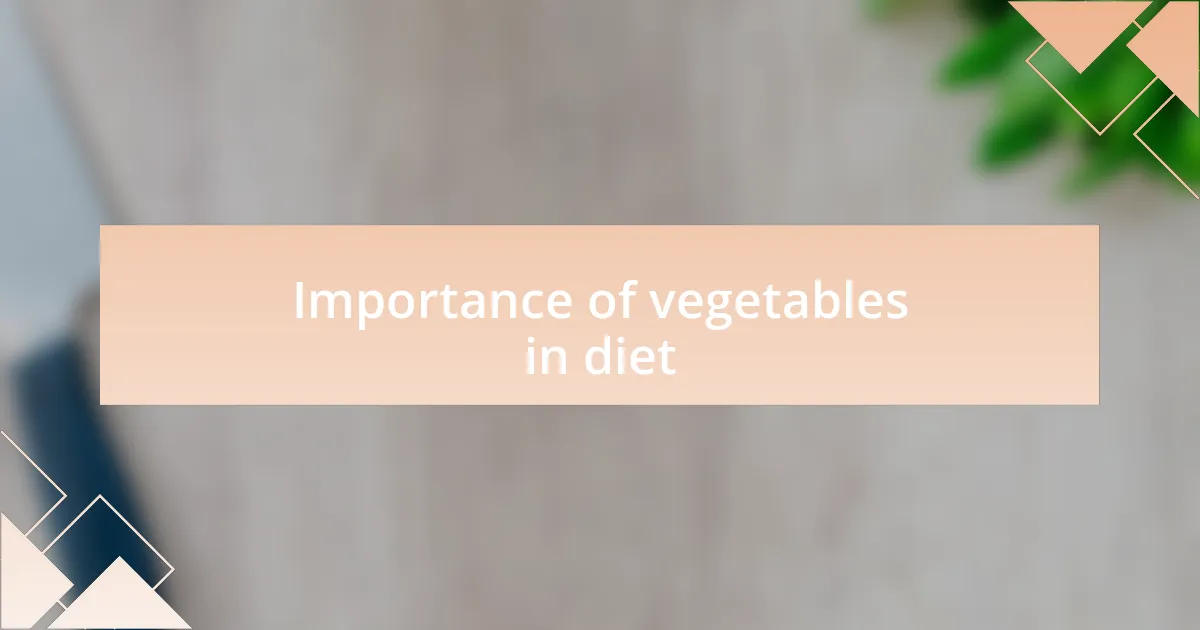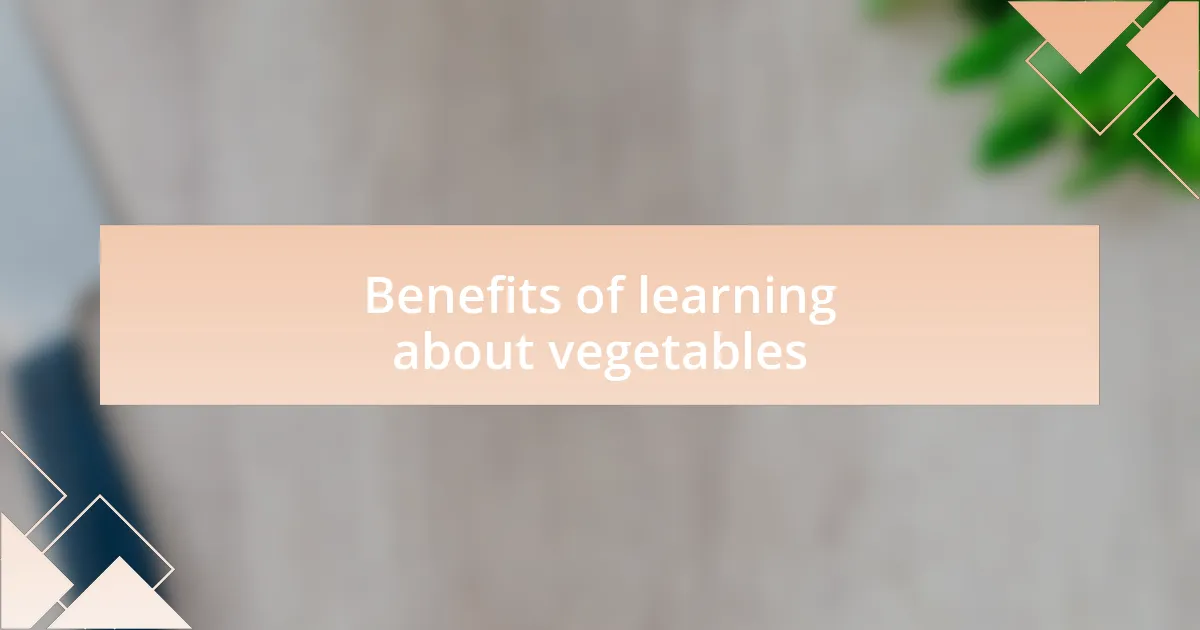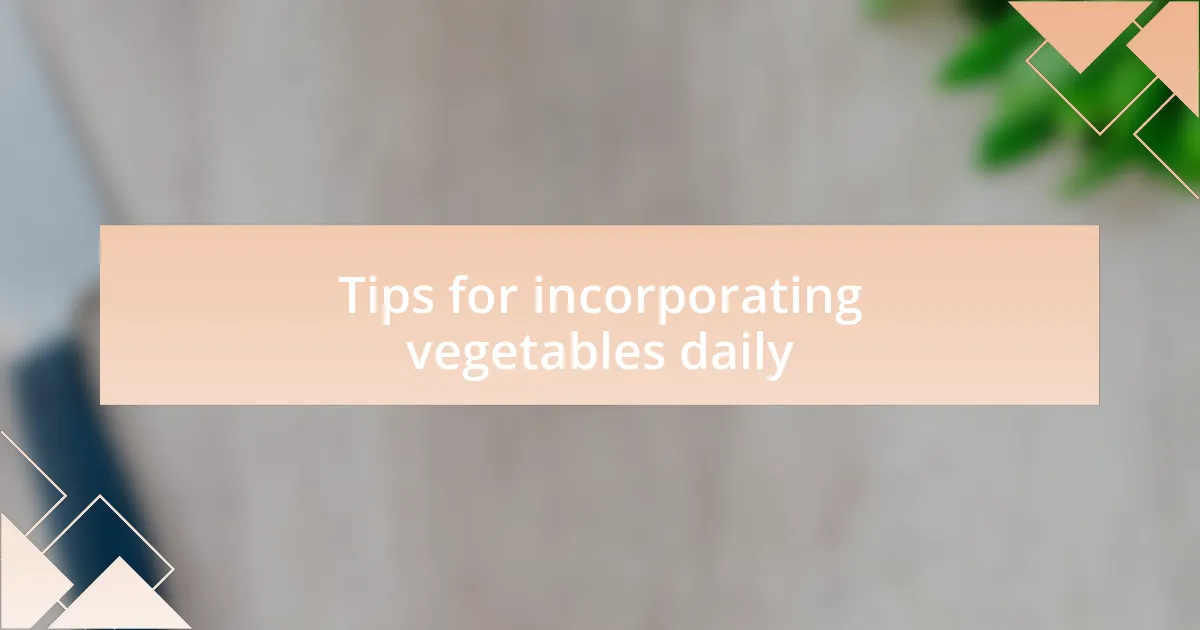Key takeaways:
- Culinary education emphasizes mastering basic cooking techniques, balancing flavors, and understanding ingredients to enhance culinary skills.
- Vegetables are essential for a balanced diet, providing nutrients, aiding digestion, and promoting long-term health.
- Exploring new vegetable varieties and cooking methods can transform perceptions and inspire creativity in cooking.
- Incorporating vegetables into daily meals can be simple and enjoyable, such as using them as the main dish or adding them to smoothies.

Culinary education fundamentals
Culinary education fundamentals start with understanding the basic techniques and methods of cooking. I remember the thrill of my first sauté; the way fresh vegetables transformed under heat left a lasting impression. Isn’t it fascinating how a simple technique can elevate the flavors and textures of what you’re preparing?
Learning to balance flavors is another cornerstone of culinary education. There was a time when I struggled with seasoning, often questioning if I had added enough or too much. It’s this delicate interplay between salt, sweetness, acidity, and bitterness that can make or break a dish, don’t you think? Together, these elements create harmony on the plate.
Ingredient knowledge is equally essential, and this is where my passion for vegetables truly blossomed. I recall a farmers’ market trip that opened my eyes to unique varieties I had never seen before. How can anyone resist the call of vibrant produce, especially when you know how to utilize each one in your cooking? Understanding their qualities not only enhances our culinary skills but also fosters a deeper appreciation for what we eat.

Importance of vegetables in diet
Vegetables play a vital role in our diets, offering an array of essential nutrients that help our bodies function efficiently. I remember the first time I learned about the power of dark leafy greens; incorporating spinach into my meals made me feel energized and vibrant. How remarkable is it that something so humble can boost our well-being so profoundly?
Beyond just nourishment, vegetables also bring diversity to our plates. I often think about the joy of experimenting with colorful bell peppers and their crisp textures. Eating the rainbow isn’t just a catchy phrase; it’s a reminder that each hue often represents different health benefits. Have you ever noticed how excited you feel when you try a new vegetable? That exploration sparks curiosity and a greater connection to what we consume.
Moreover, the inclusion of vegetables in our diets aids in digestion and supports long-term health. I once struggled with sluggishness and bloating until I made a conscious effort to add more fiber-rich veggies to my meals. Isn’t it incredible how broccoli and carrots not only satisfy but also promote a healthier gut? By embracing vegetables, we invest in our health, fueling our bodies with the care they genuinely deserve.

Benefits of learning about vegetables
Learning about vegetables opens the door to a treasure trove of culinary possibilities. One of my favorite experiences was discovering how to roast brussels sprouts with a drizzle of balsamic glaze. That small learning moment transformed my view of these often-overlooked veggies from bitter to beautifully caramelized, igniting a passion in me for trying new cooking techniques. Have you ever tasted something that changed your perception entirely?
Additionally, understanding the unique properties of different vegetables helps us make informed choices in our meals. For instance, I used to disregard beets, thinking they were too earthy for my palate. However, after learning about their sweetness and nutritional benefits, I began adding them to salads. The satisfaction of finding a vegetable that I once dismissed has enriched my culinary journey in unexpected ways. Each time I try a new vegetable, I not only expand my taste buds but also my knowledge and appreciation for what nature provides.
Furthermore, realizing the health benefits associated with specific vegetables allows us to enhance our well-being proactively. I recall a period when I was feeling run down and decided to boost my intake of antioxidants by incorporating more colorful vegetables like tomatoes and red cabbage into my diet. That intentional shift not only improved my energy levels but also deepened my understanding of how each vegetable contributes uniquely to our health. Isn’t it fascinating how something so simple can profoundly impact our daily lives?

Discovering new vegetable varieties
Exploring different vegetable varieties can be an adventure that often leads to delightful surprises. I vividly remember my excitement when I stumbled upon Romanesco at a local farmer’s market. Its whimsical fractal patterns caught my eye, and the moment I tasted its mildly nutty flavor, I realized I had discovered a new favorite. Have you ever indulged in a culinary find that left you eager to share it with friends and family?
What strikes me most about uncovering new vegetable varieties is the way they can change your cooking routines. For example, the day I first cooked with purple carrots was transformative. Their vibrant color not only brightened my dish but also encouraged me to experiment with flavors. The joy of presenting something so visually appealing on my table reminded me why I fell in love with cooking in the first place. Why not challenge yourself to select a vegetable you’ve never tried before?
With each new vegetable I encounter, I find myself more inspired to dive deeper into the culinary world. I recall a culinary class where we learned about heirloom tomatoes, each with its unique color and taste. After that session, I was so inspired that I made it a point to seek out local varieties at farmers’ markets. Each tomato offered a new experience, enriching my appreciation for the diversity of flavors and textures. Isn’t it remarkable how nature’s creations can motivate our cooking journeys?

Experimenting with cooking methods
Experimenting with different cooking methods opened a whole new world for me when it came to vegetables. I distinctly remember the first time I decided to roast Brussels sprouts instead of simply boiling them. The caramelization brought out a sweetness that transformed my perception of these little green gems. Have you ever been surprised by how a simple cooking technique can entirely change the flavor of a vegetable?
I also ventured into the realm of steaming after hearing about its health benefits. I still recall the vibrant green hue of steamed asparagus on my plate, topped with a sprinkle of sea salt and a dash of lemon juice. The crispness and subtle flavor enhanced my appreciation for fresh vegetables. It made me realize that sometimes, less is more when it comes to cooking. How do you like to prepare your vegetables for maximum taste?
One of my most memorable experiments involved grilling zucchini. The way the smoky char mingled with its natural sweetness was nothing short of phenomenal. I paired it with a balsamic glaze, and suddenly, grilling became my go-to method for preparing summer vegetables. It was a delightful surprise that ignited my passion for outdoor cooking. Have you ever tried a cooking method that made you fall in love with a vegetable all over again?

Personal journey to vegetable appreciation
I’ll never forget the moment I first tasted a fresh garden tomato straight off the vine. The explosion of juiciness and flavor utterly captivated me. How could something so simple bring such joy? That experience sparked my interest in growing my own vegetables, and watching them flourish taught me to appreciate their journey from seed to table.
As I began to explore local farmers’ markets, I was amazed by the variety of vegetables available. One particular trip left a mark on me when I discovered heirloom carrots in a rainbow of colors. The vivid shades intrigued me, and I felt a burst of excitement as I imagined a colorful salad. Have you ever felt inspired by the vibrant colors of fresh produce? It reminded me that vegetables can be a feast for the eyes as much as for the palate.
Through these experiences, I learned that my connection to vegetables extended beyond just the flavors; it’s also about the stories they carry and the care that goes into growing them. This newfound appreciation transformed me from someone who merely tolerated vegetables into someone who actively sought them out, eager to incorporate them into meals. What stories do your favorite vegetables tell you?

Tips for incorporating vegetables daily
One of the best ways I’ve found to incorporate vegetables into my daily routine is to start small. Adding a handful of spinach to my morning smoothie not only boosts the nutrient content but also makes the drink vibrant and refreshing. Have you ever noticed how a simple addition can elevate your breakfast?
Another fantastic tip is to make vegetables the star of the meal rather than just a side dish. When I began experimenting with roasted vegetable medleys, I discovered how the caramelization brought out an entirely new depth of flavor. It’s amazing what a bit of olive oil and seasoning can do. When was the last time you highlighted vegetables as the main attraction on your plate?
Lastly, I’ve learned to keep my pantry stocked with frozen vegetables for those busy nights. They’re convenient and often just as nutritious as fresh ones. When I toss frozen peas into pasta or stir-fry, it feels like a win-win situation: I’m eating well, and dinner is ready in no time. Doesn’t it feel good to know that adding nutrition to your meals can be so simple?